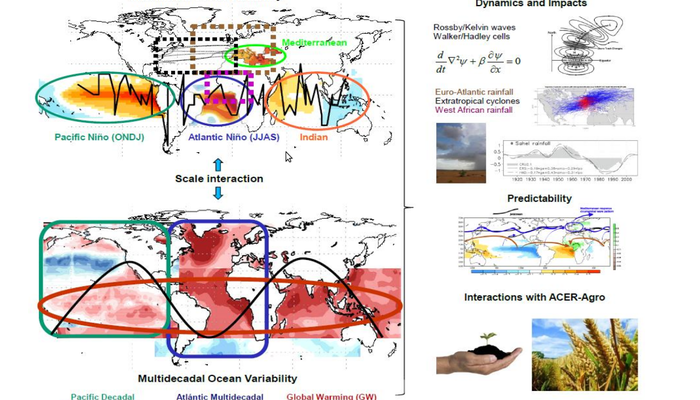

The TROPA UCM group has developed a broad experience in climate variability studies during the last 10 years. The group has focused its attention on the study of the Tropical and Extratropical Atlantic Variability, in particular in air-sea interactions (Polo et al., 2005, 2008a,b), SST forced tropical and extratropical atmospheric teleconnections and impacts, relation to the Tropical Atlantic (Rodríguez-Fonseca and Castro, 2002; Rodriguez-Fonseca et al., 2006; García-Serrano et al., 2008; Losada et al., 2007; Losada et al., 2010b) and North Atlantic Oscillation forcings (Gomara et al, 2014,2015). Besides, TROPA group has done a step forward on the understanding of West African Moonson (Rodríguez-Fonseca et al. 2011; Losada et al.2010a; Mohino et al. 2011a,b,c,d) through the research developed for the European project AMMA-EU.
The group has worked in tropical Atlantic and Pacific SST variability in relation to its impacts on North Atlantic climate variability, applied to the Euro-Atlantic sector (Rodríguez-Fonseca et al., 2002; Rodríguez-Fonseca and Castro, 2002; Rodríguez-Fonseca et al., 2006; Losada et al., 2007; García-Serrano et al.2011a,b; Losada et al. 2012a; López-Parages and Rodríguez-Fonseca 2012, López-Parages et al, 2014,2015,2016), the explosive cyclogenesis (Gómara et al. 2014a,b), the West African Monsoon region (Mohino et al. 2011a,b; Polo et al. 2011; Rodríguez-Fonseca et al., 2011, Losada et al. 2012b) and the Southeastern Africa (Angola) area (Rodriguez Fonseca and Xavier, 2009). TROPA group has opened a new line of investigation regarding the changes of the interannual variability modes of the tropical Atlantic and Pacific regions, their connection, impacts and multidecadal modulations (Polo et al., 2008; Rodríguez-Fonseca et al. 2009, 2011; Mohino et al. 2011b; López-Parages and Rodríguez-Fonseca 2012; Losada et al. 2012b; Martín-Rey et al. 2012;2014).
The multidecadal variability of the Atlantic and Pacific Oceans has been investigated through the analysis of the lastest state-of-art climate models, trying to isolate the internal and externally forced variability (Villamayor and Mohino 2014). Also , an evaluation of the decadal predictions in the frame of the CMIP5 project has been achieved recently in relation to the Sahelian rainfall (Mohino et al., 2016). Nowadays, TROPA is a reference group at international level, with published results in impacting journals and participation in European projects.
The group has achieved a background in data analysis (observations and models), determination of predictors for seasonal to decadal forecast, and a thorough knowledge of teleconnection dynamics, air-sea interactions and associated impacts. The group has developed skills in numerical simulations with General Circulation Models. In particular, the Speedy GCM, UCLA-AGCM and UCLA-AGCM-MIT-OGCM models and NEMO models. Moreover, the group has applied its knowledge about climate teleconnections in developing a statistical prediction tool, which considers different predictor fields and includes the non-stationarity of the teleconnections (Suárez and Rodríguez-Fonseca 2014).